{{{description}}}
There is plenty of birdlife in Blue Mountains. They range in colour, size and they also make a wide range of sounds.
(Alisterus scapularis) It's endemic to eastern Australia. It's 43 cm long, including the tail. Males have a red head, breast, and lower undersides, and green back, wings and tail. It has a blue band on the back of the neck. Females have a green head and breast and a grey beak.

(Cracticus tibicen) It's 37 to 43 cm long with distinctive black and white plumage, gold-brown eyes and a bluish-white and black bill. The difference between females and males is seen on their back markings. Males have white feathers while females have white-grey feathers. The Australian magpie is a very good singer with an array of complex vocalisations.
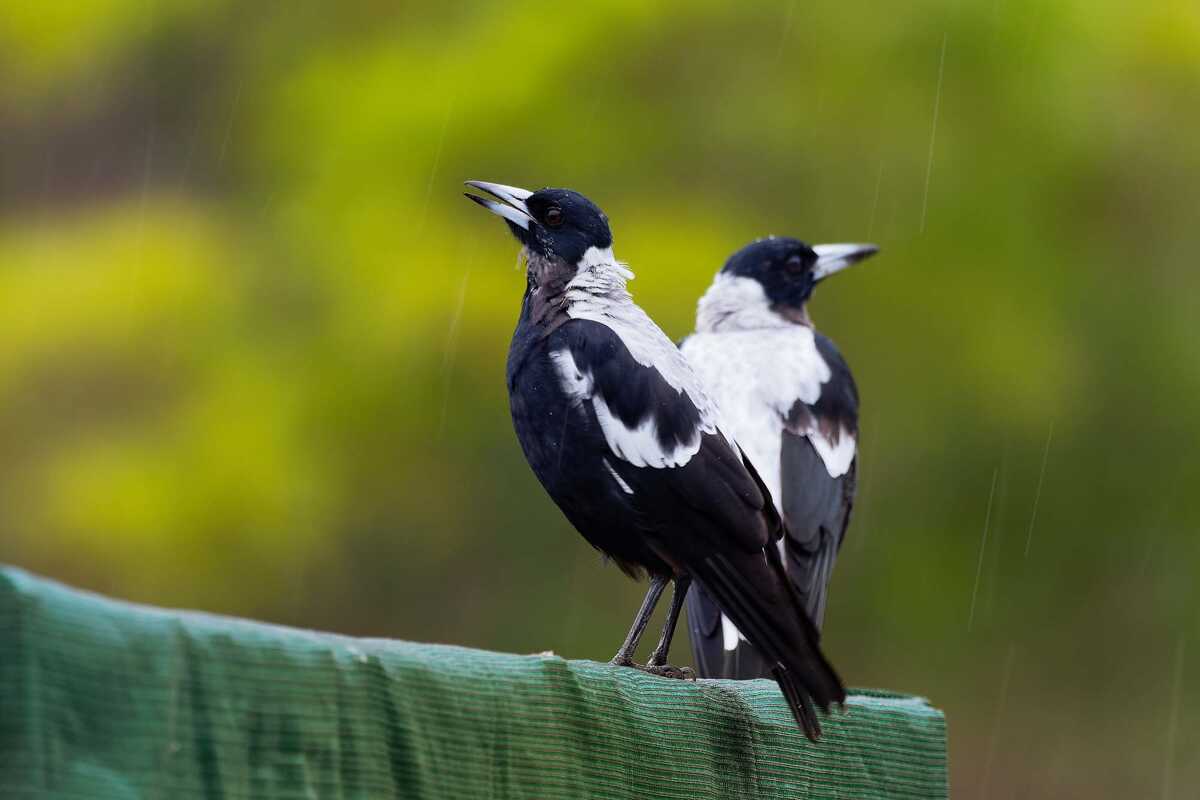
(Corvus coronoides) It's 46–53 cm long with all-black feathers, beak and mouth, strong grey-black legs and feet. It has prominent throat hackles, which are in adult birds and white irises.
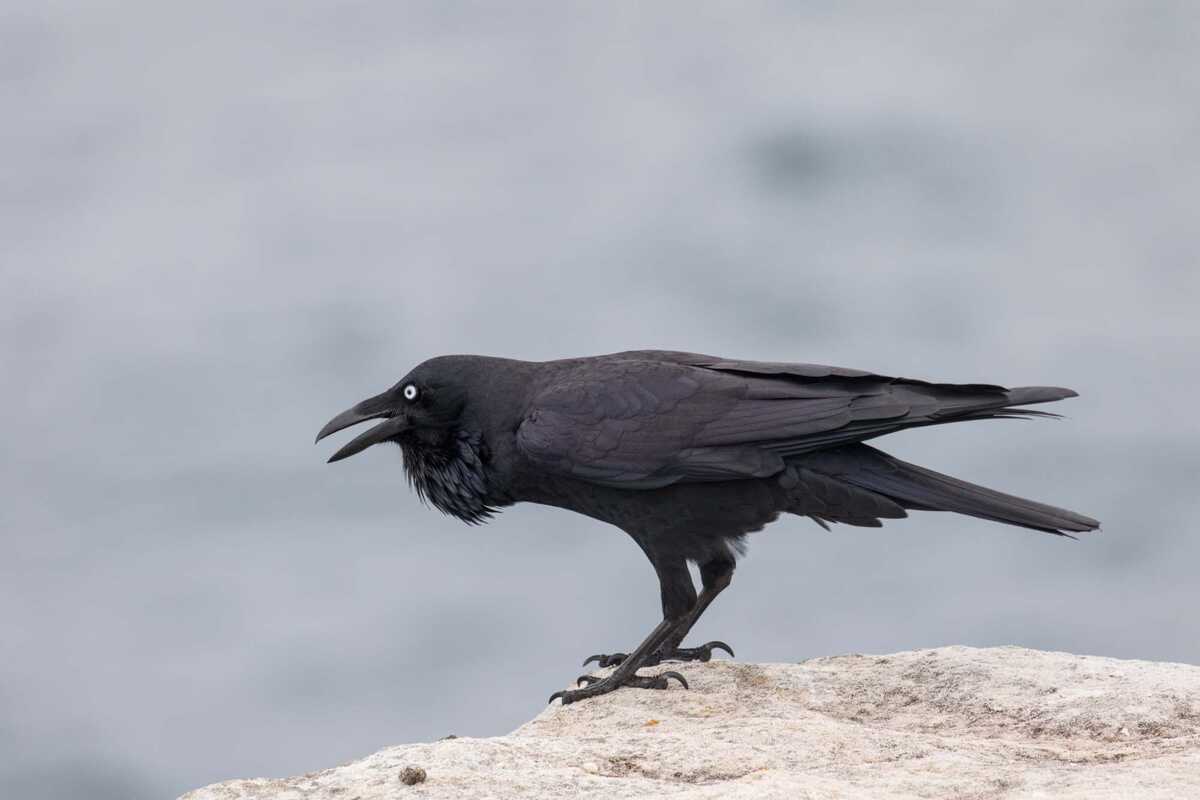
(Chenonetta jubata) It's 45–51 cm long and looks like a small goose, mostly feeding by grazing. Males are grey with a dark brown head and mottled breast. Females have white stripes above and below the eye and mottled underparts. They all have grey wings with black primaries and a white speculum.
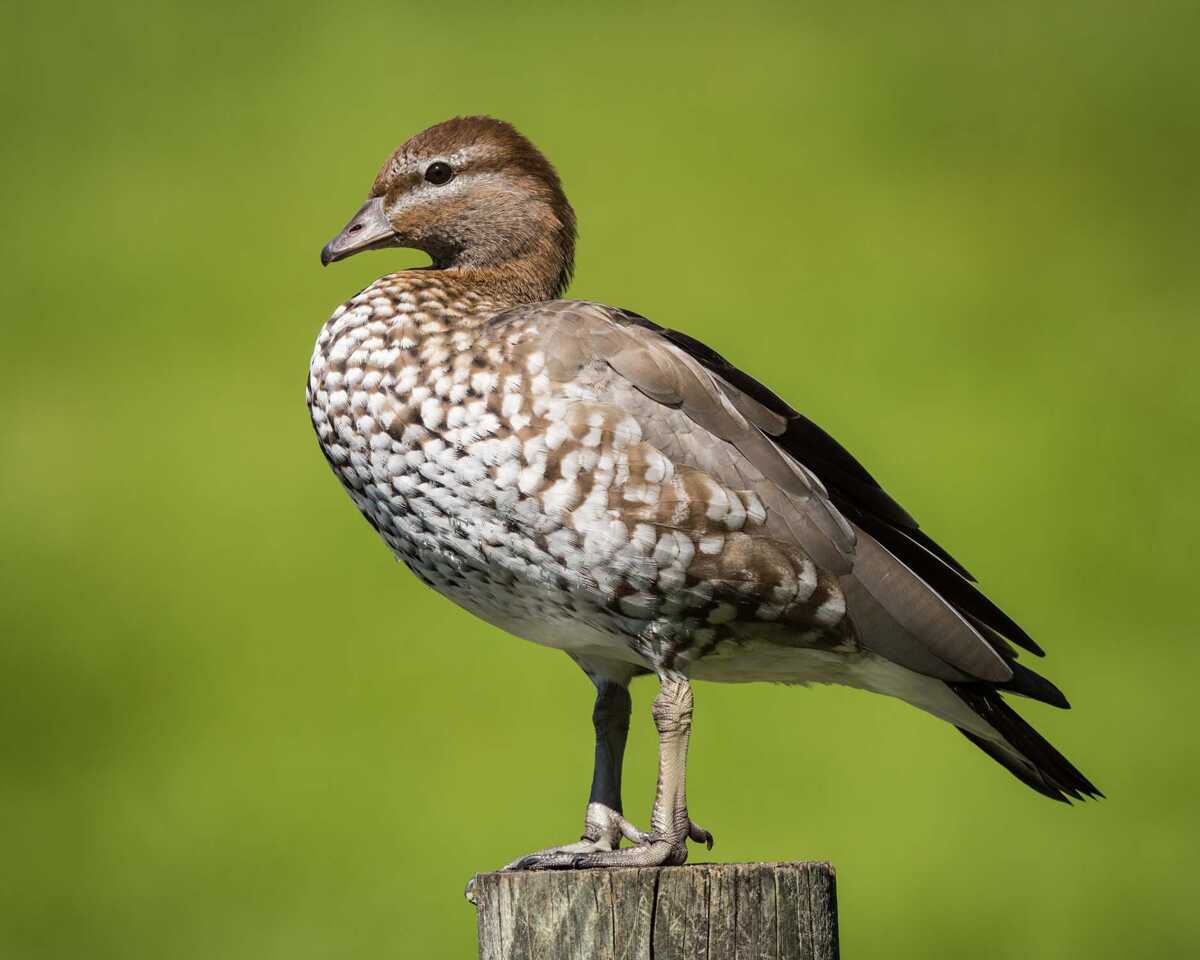
(Manorina melanophrys) It's 17.5 - 20 cm long with olive-green plumage, darker on the wings and yellower on the belly. Its bill is yellow and slightly downturned. Its legs are bright orange, the crown and lores are black, feathers in front of the eye are yellow and the bare patch behind the eye is red-orange.
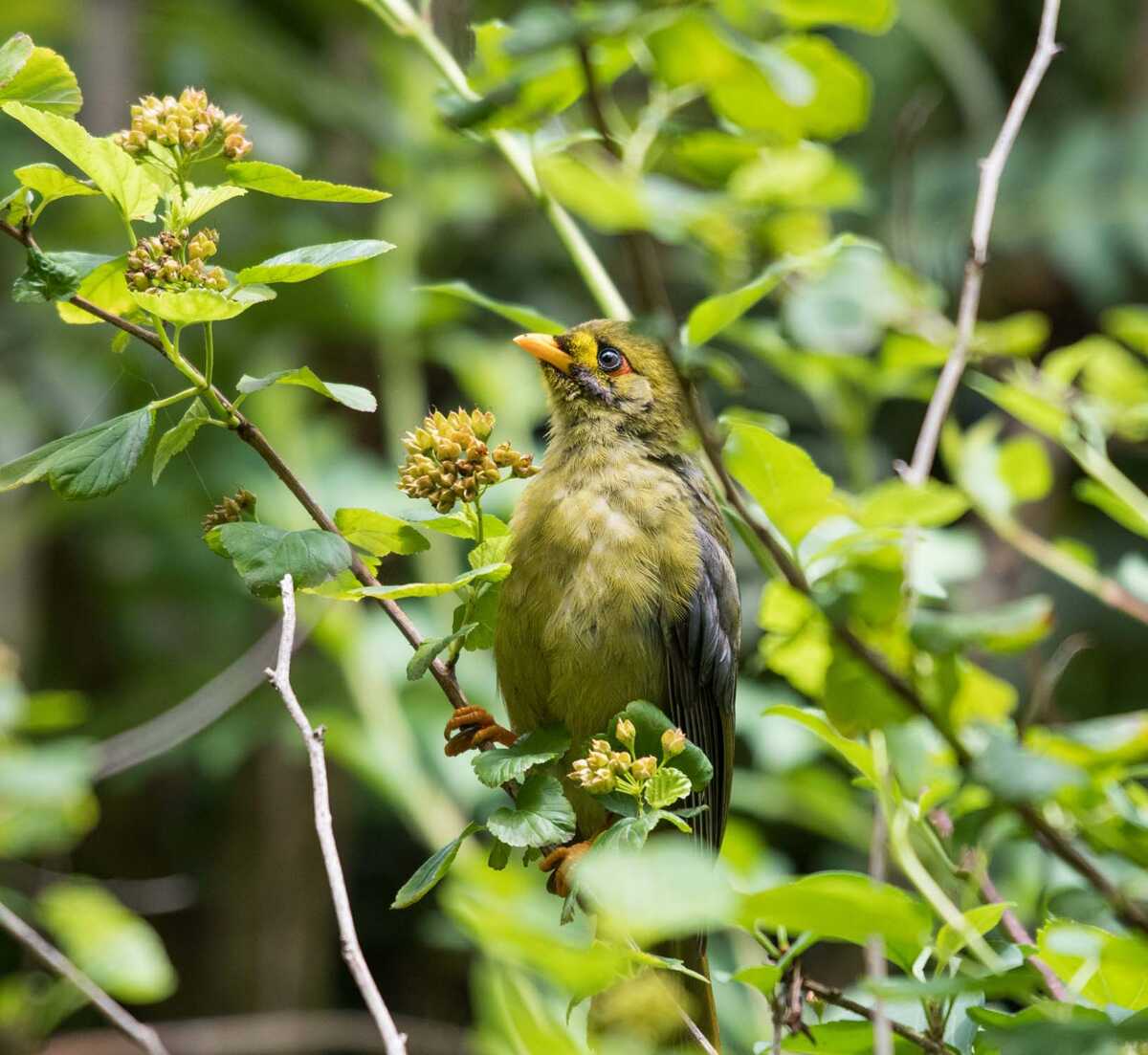
(Melithreptus brevirostris) It's 13 - 15 cm long with olive-brown feathers above and buff below. It has a brown head, nape and throat, and a cream or orange patch of bare skin over the eye with a dull white patch on the nape. It has orange legs and makes a scratchy chwik-chwik-chwik call.

(Coracina tenuirostris) This is a medium-sized cuckoo-shrike. Males have dark-blue grey plumage with black bill and dark legs. Females have brown-grey plumage above and white underside with fine black lines. They have a horizontal dark eye stripe.
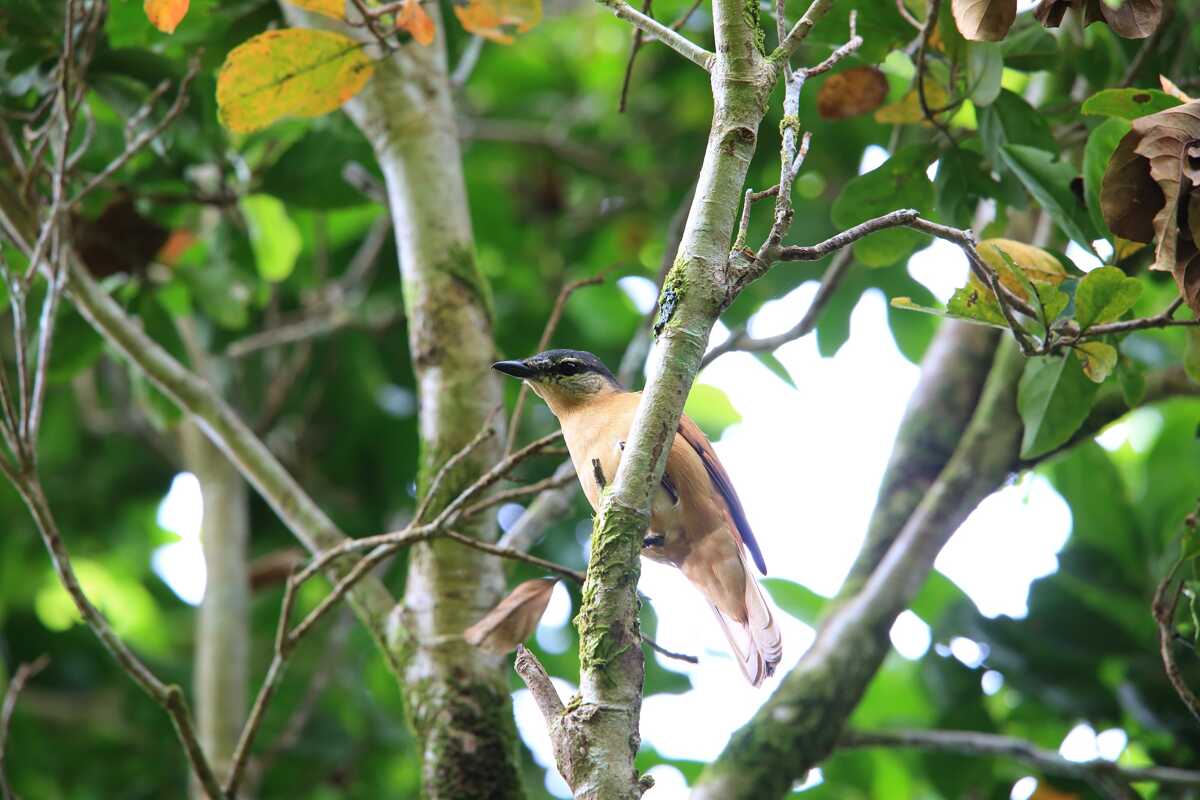
(Ocyphaps lophotes) It's 30 - 34 cm long with grey colouration that has tinges of brown and green and a feathered black spike on top of its head. The skin around the eyes is bright orange. Wings have black stripes with primary feathers in brown, purple, blue, and green.

(Platycercus elegans) This bird is native to eastern and south-eastern Australia. It's 36 cm long, most of which is its tail. It has blue cheeks, pale grey bill and dark brown irises. It has black-scalloped blue-margined wings and mostly blue tail. Head and belly are red.
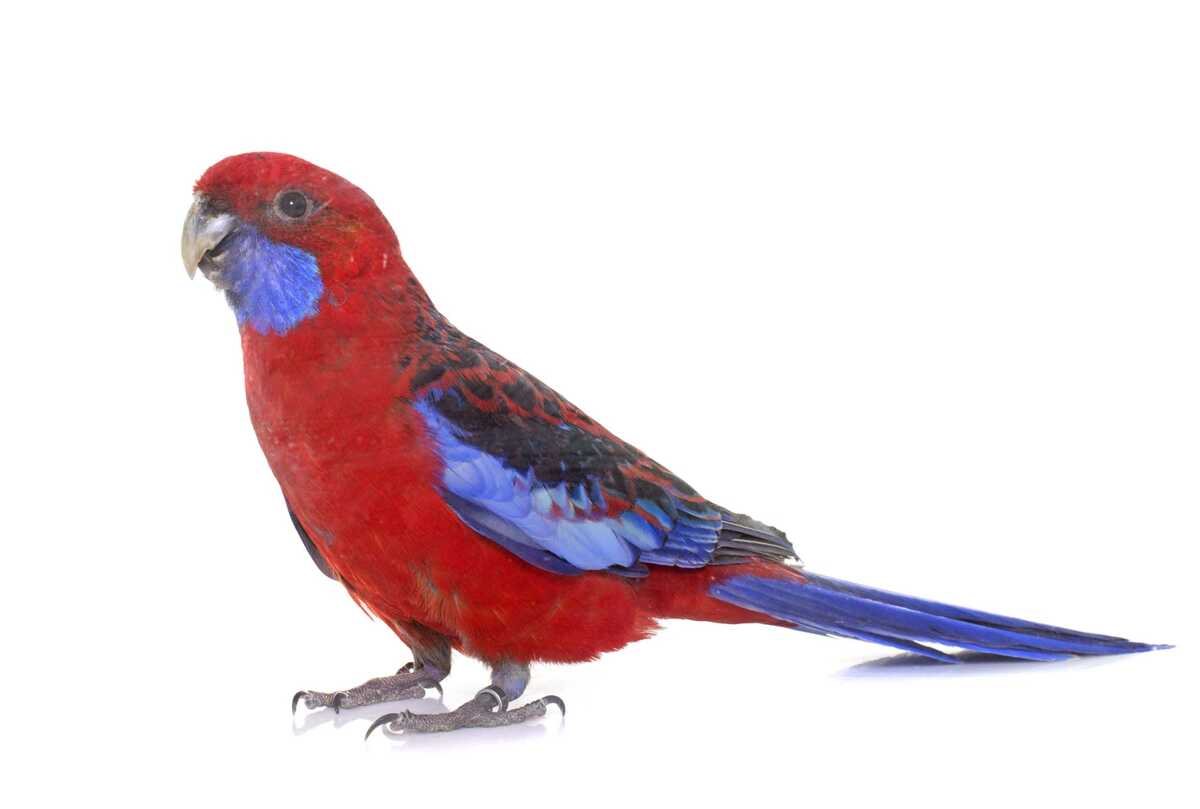
(Eudynamys orientalis) It's 40 - 46 cm long. Males have glossy black plumage and striking red eyes. Females have brown upperparts with numerous white spots, a black crown and buff cream underparts with fine black bars.
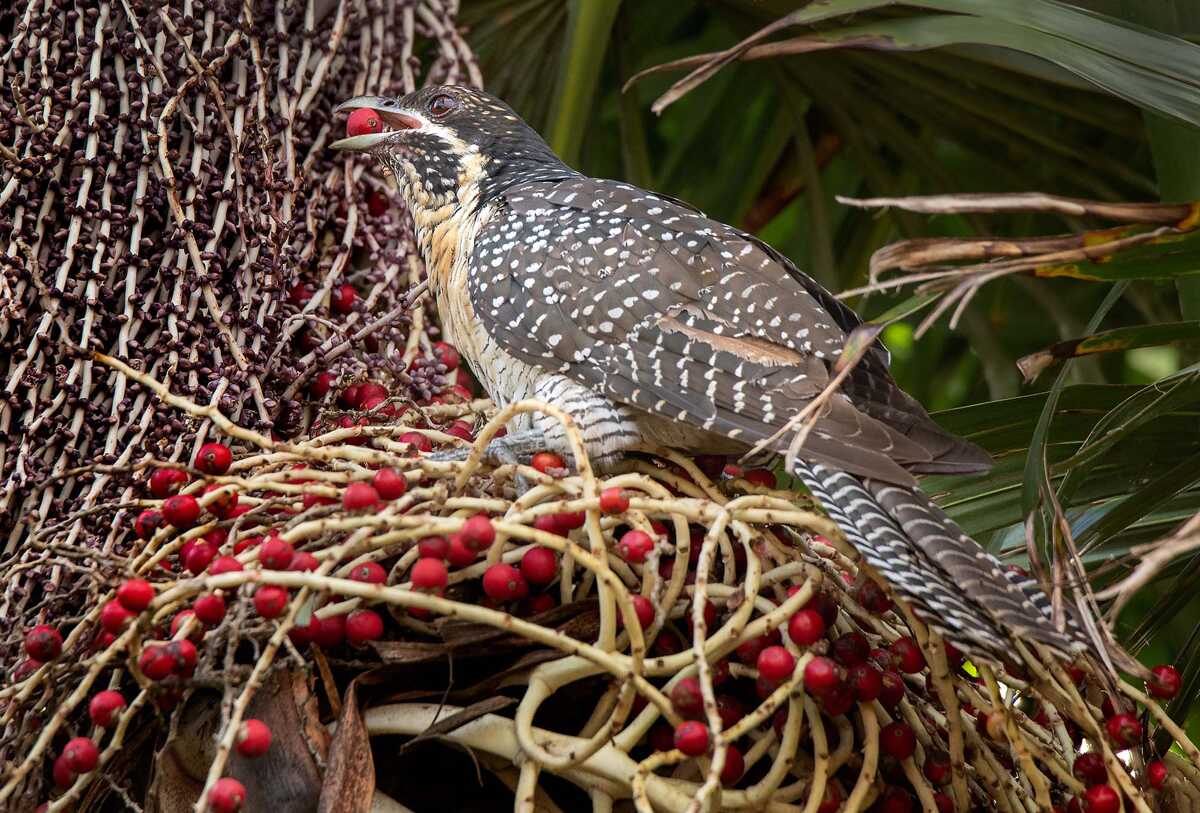
(Platycercus eximius) This rosella is native to south-east of the Australian continent and to Tasmania. It's 30 cm long with a red head, white cheeks and beak and brown irises. Its brest is red at the top and yellow fading to pale green over the abdomen. It has black back plumage, with bluish wings and lateral tail and a dark green tail. Its legs are grey. Females are similar though duller in colour with an underwing stripe, that males to not have.
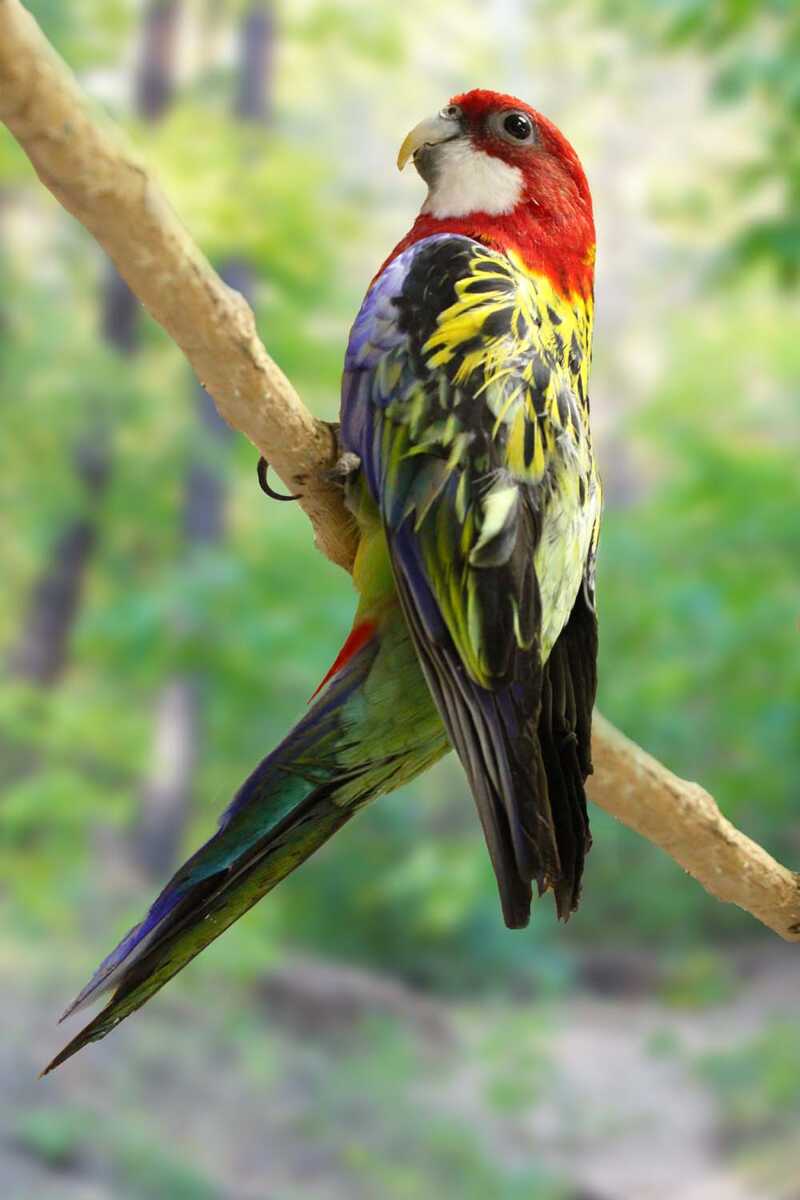
(Acanthorhynchus tenuirostris) It's 13–16 cm long with a long thin downcurved black bill, black head, white throat with a chestnut patch and red irises. Its nape is brownish-red, the back is a grey-brown and underparts are pale cinnamon. The dark tail has a white tip. Smaller females are duller in colour with an olive-grey crown. The birds call is a clear, high-pitched, staccato piping "chip-chip-chip".
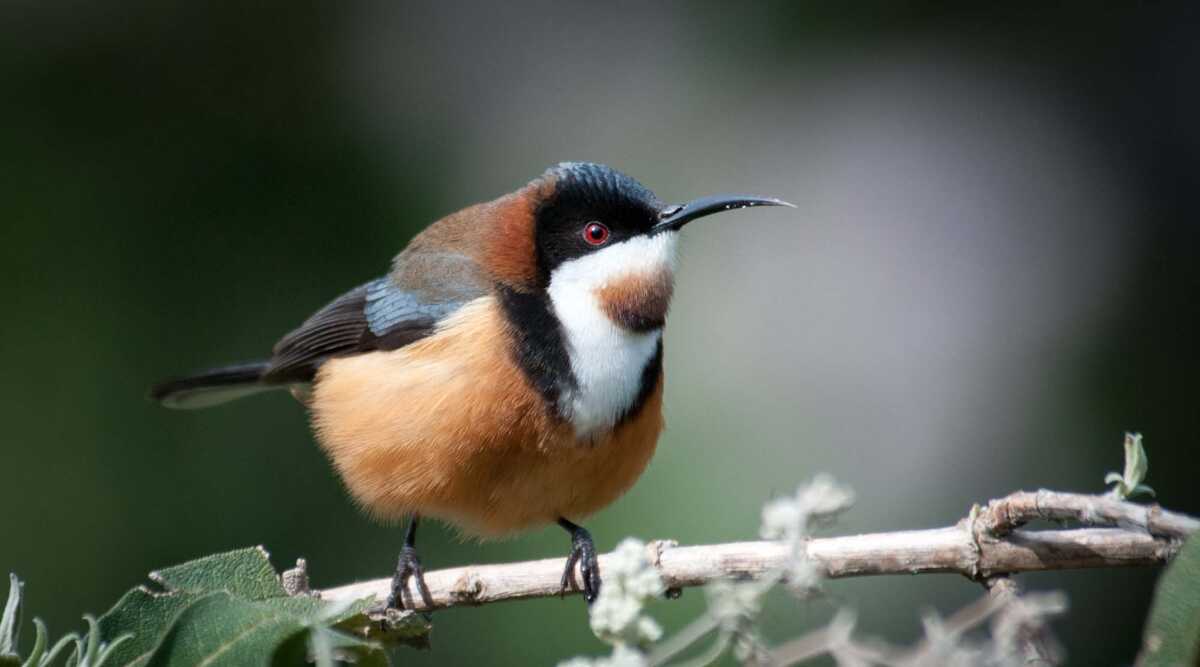
(Psophodes olivaceus) This bird is native to the east coast of Australia. It's 26–30 cm long with olive-green plumage, a black head, bill and breast and a small black crest with a white cheek-patch on its face and brown irises. Its abdomen is paler, its long dark olive-green tail has a white tip and its feet are of a blackish colour. This is generally a shy which is more often heard than seen. Its call is a long note, followed by a "whip crack" and some more notes, and is most frequent in the early morning.
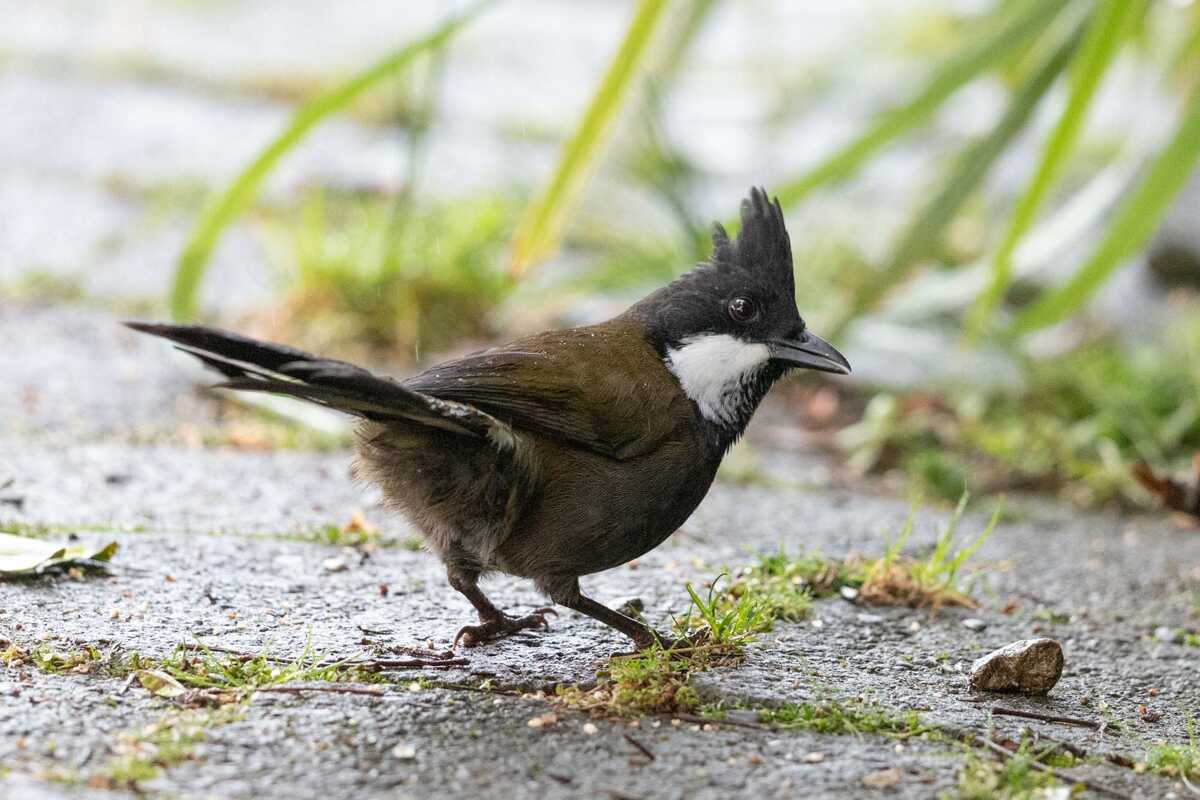
(Eolophus roseicapillus) Galah is endemic to Australia. It's 35 cm long with a pale silver to mid-grey back, a pale grey rump, a pink face and chest, and a light pink mobile crest. It has grey legs, a light coloured beak and bare skin around eyes. Males have very dark brown irises while females have mid-brown or red irises.
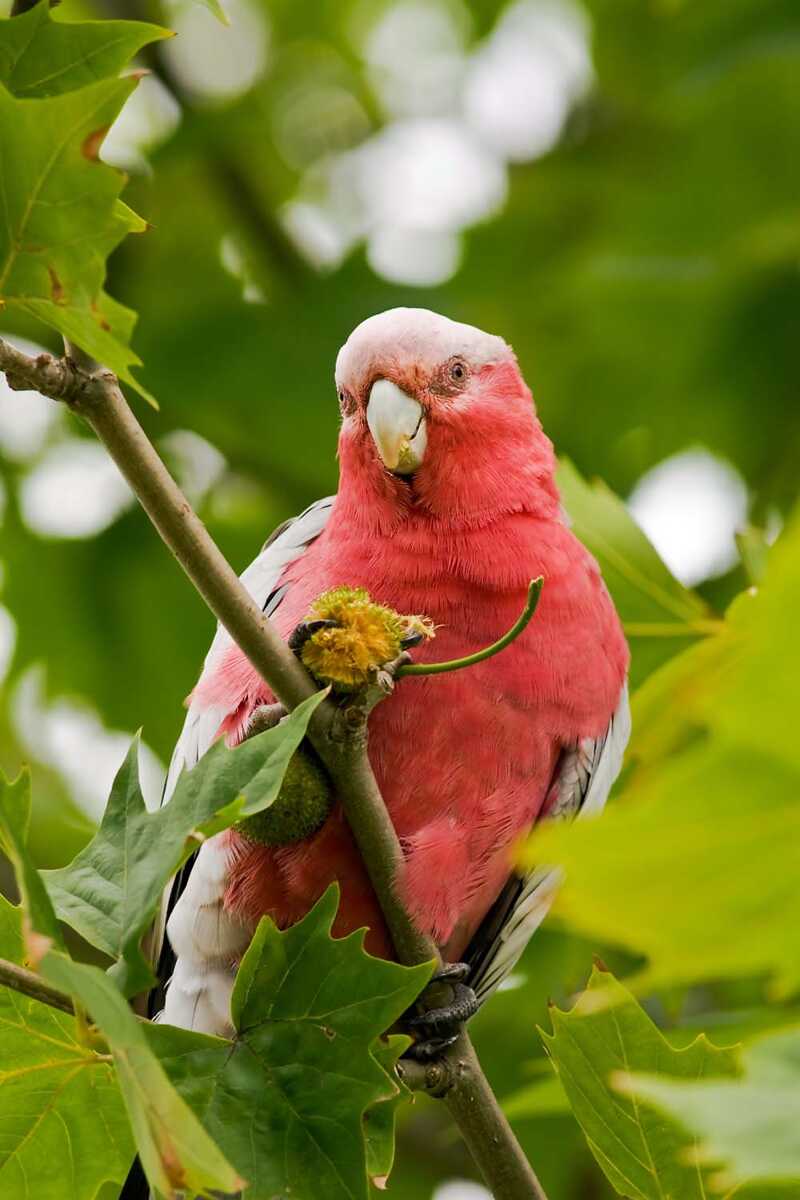
(Callocephalon fimbriatum) It's 35 cm long with grey plumage. Males have a bright red head and crest while females are dark grey. In underparts the feathers have yellow or pink edges and in upperparts paler grey.

(Rhipidura albiscapa) It's 16-18 cm long with mid-to-dark grey or grey-brown plumage above, lighter below, a white throat, white markings over the eye. Its white-edged or completely white outer tail feathers are often displayed fanned out. Its almost metallic cheek call is made either as a single sound or as chattering.

(Meliphaga lewinii) It's 20–22 cm long with dark greenish-grey plumage, a creamy yellow gape and large, yellowish ear-patches, which distinguish it from other honeyeaters. Its bill is black and eyes are blue-grey. Both sexes are similar in appearance. Young Lewin's honeyeaters are similar to the adults but have brown eyes. Its call sounds like a machine gun and can be heard over long distances.
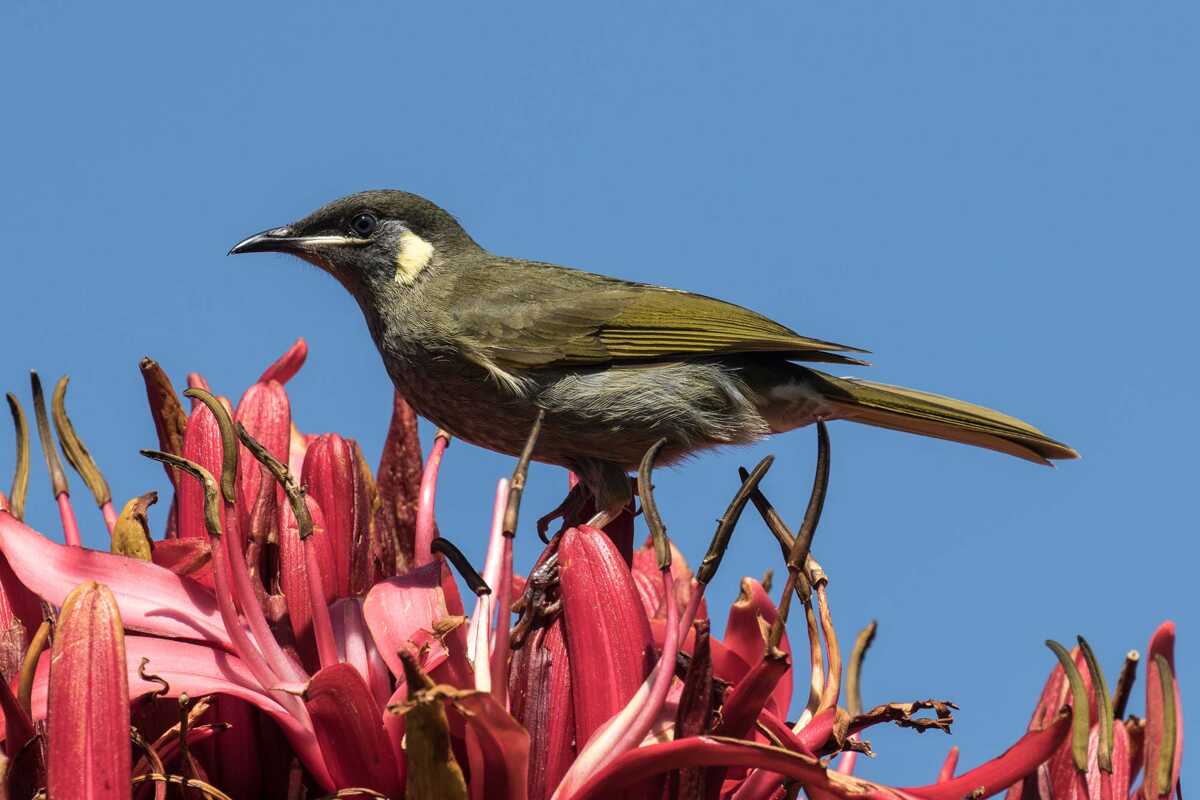
(Microcarbo melanoleucos) It's 56–58 cm long with black plumage above, white beneath and small black crest. Its 3 cm yellow bill and black tail differentiate it from the little black cormorant. Its legs and feet are black. It makes a low cooing during courtship.
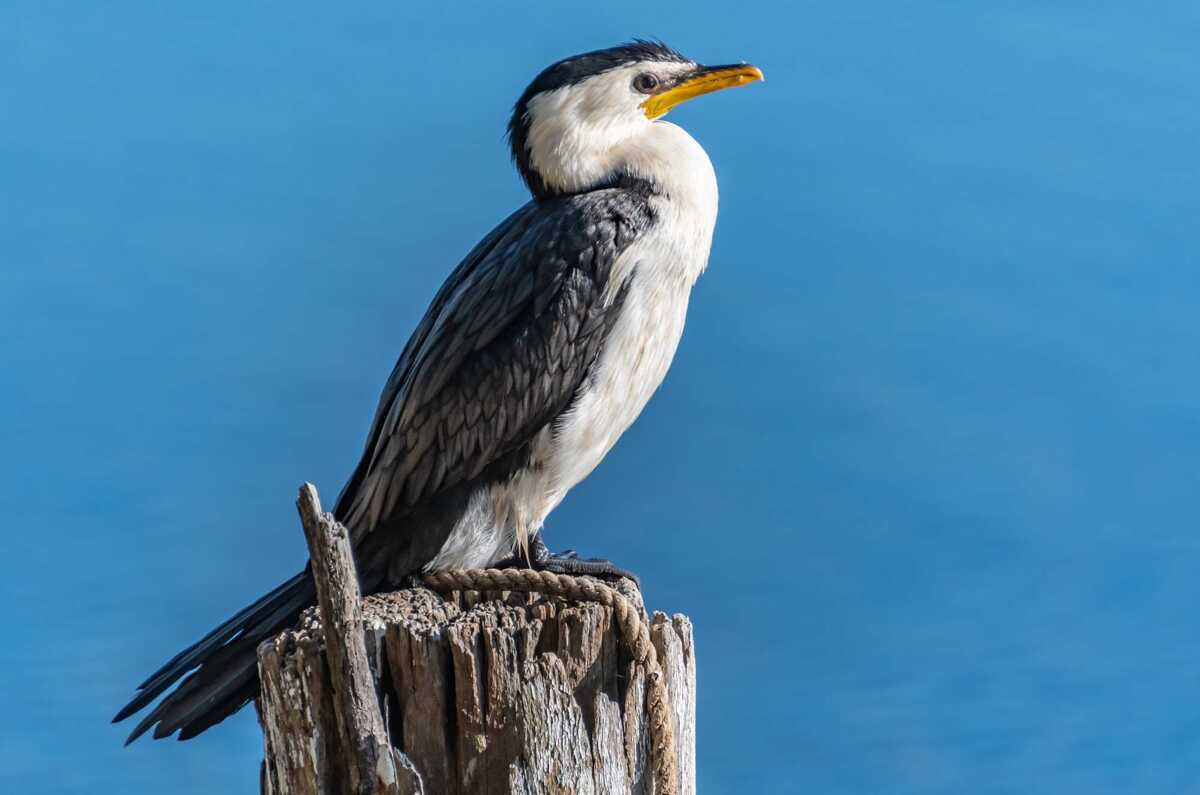
(Grallina cyanoleuca) It's 25 - 30 cm long, and boldly pied in black and white. Males and females look alike but have different patterns. Females have a white throat while males have a black throat and a white "eyebrow".
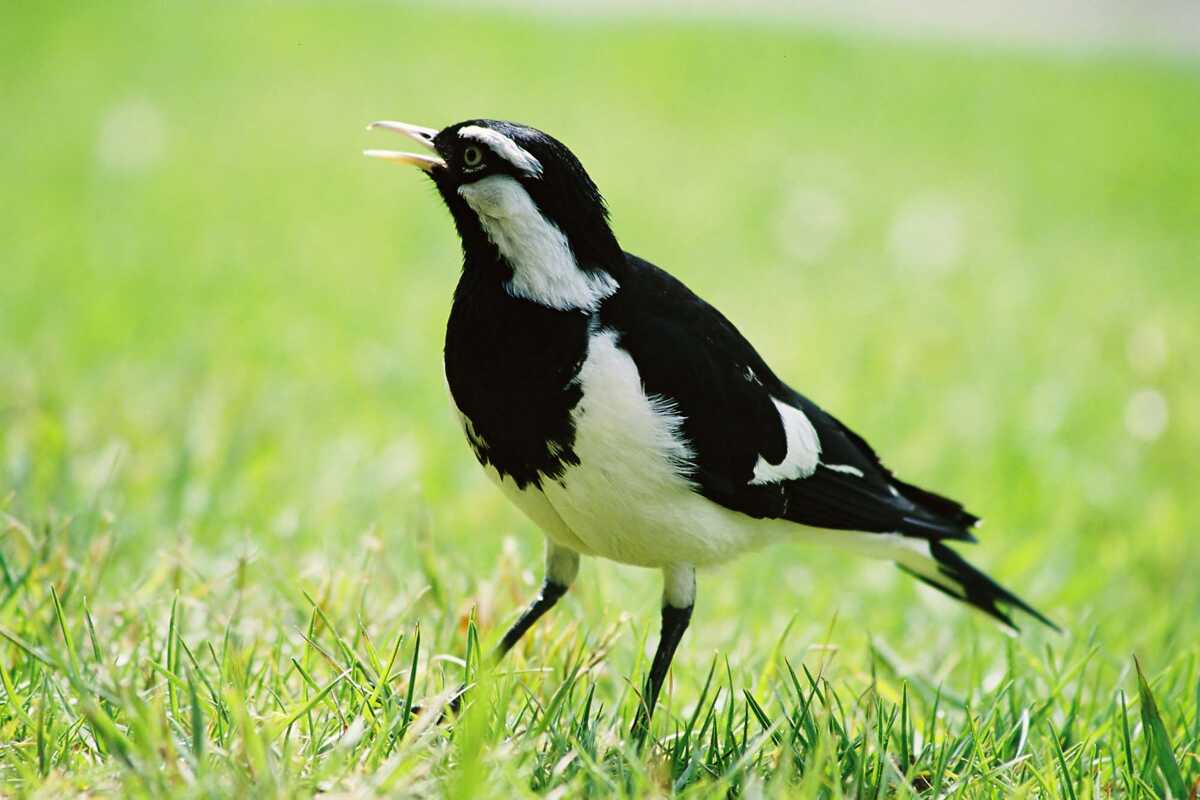
(Manorina melanocephala) This bird is endemic to eastern and southeastern Australia. It's 25-28 cm long with grey plumage, a black crown and cheeks, orange-yellow beak and feet, and a distinctive yellow patch behind the eye. Its tail feathers have white tips. Its vocalisation ranges of songs, calls, scoldings and alarms.

(Anas superciliosa) It's 54–61 cm long with mid-brown plumage, a paler head with dark crown and dark brown line through the eye, bordered with cream above and below. It has a green speculum and pale underwing.

(Ninox strenua) This bird is native to SE and E Australia and is the largest owl on the continent. It's 45 to 65 cm long with a long tail with six narrow white bars, large yellow eyes, a protruding bill, distinct brow ridges on a small head. The upperparts plumage is dark grey-brown, mottled and barred with whitish. The underparts are white with bold grey-brown V-shaped barring.
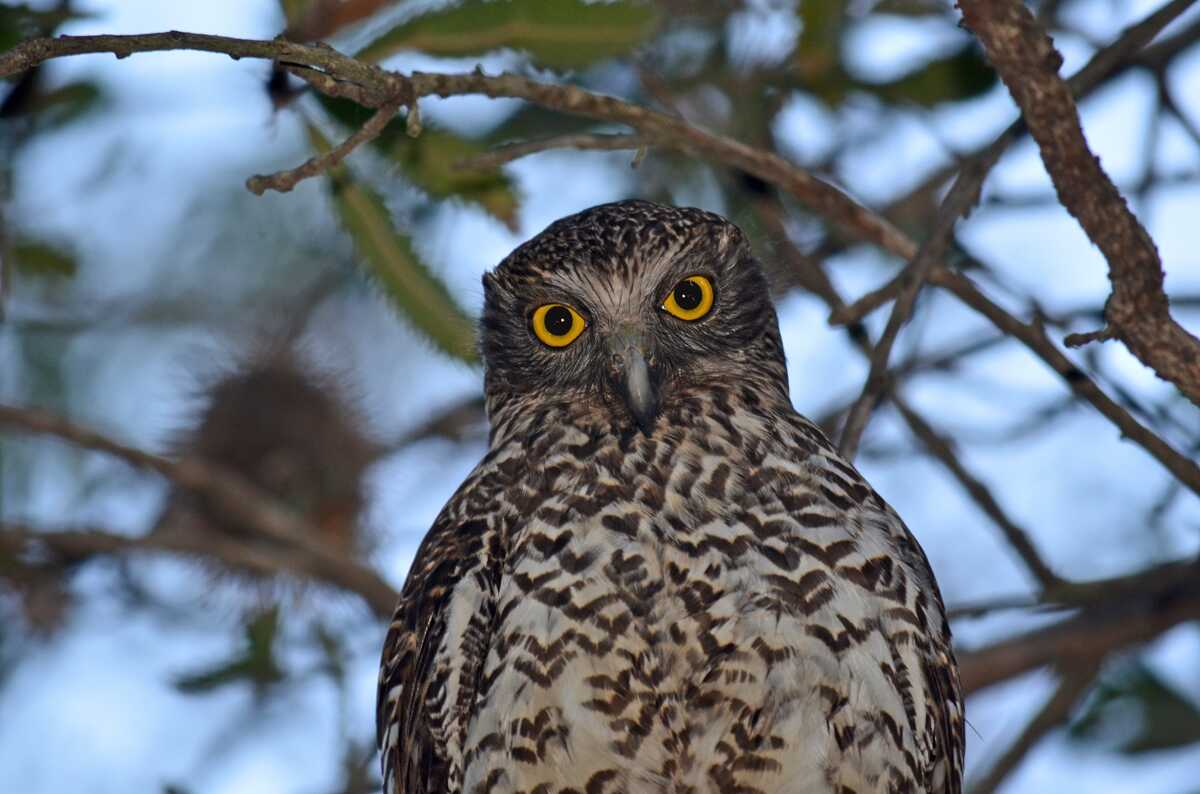
(Trichoglossus haematodus) It's 25 - 30 cm long with deep blue plumage on the head, a greenish-yellow collar, and green wings, back and tail. Its chest is orange-yellow with a blue belly.

(Ptilonorhynchus violaceus) This bird is endemic to eastern Australia. Males have violet-blue eyes and black plumage. Females distinctively green/brown or otherwise entirely brown upper body and lighter underbody with a distinct reticulated or scalloped pattern, but with very striking blue eyes.
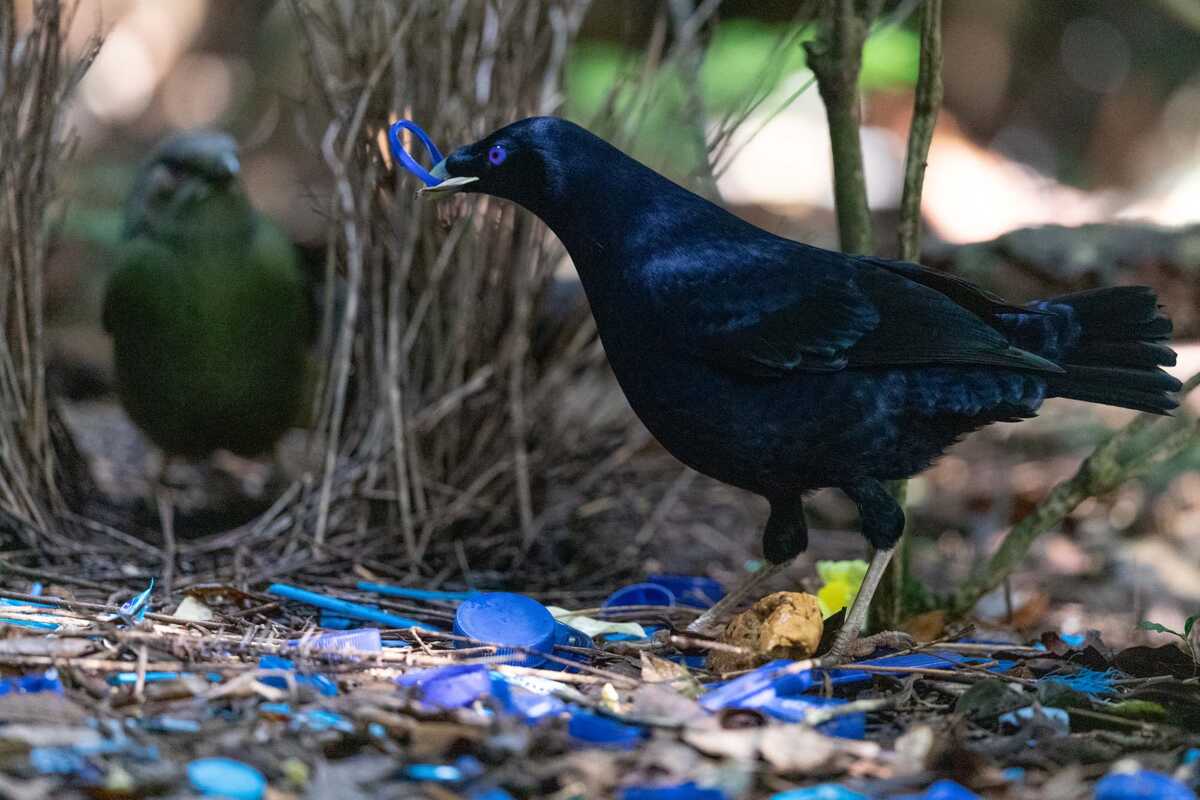
(Tyto tenebricosa) It's 45cm long with dark eyes on a heart-shaped grey facial disc. Its plumage is dark grey with fine white spotting above and below, and a pale belly.

(Ninox boobook) Native to Australian mainland this owl is also the smallest owl in this area. It's 27 - 36 cm long, with mostly dark-brown plumage with prominent pale spots and grey-green or yellow-green eyes.
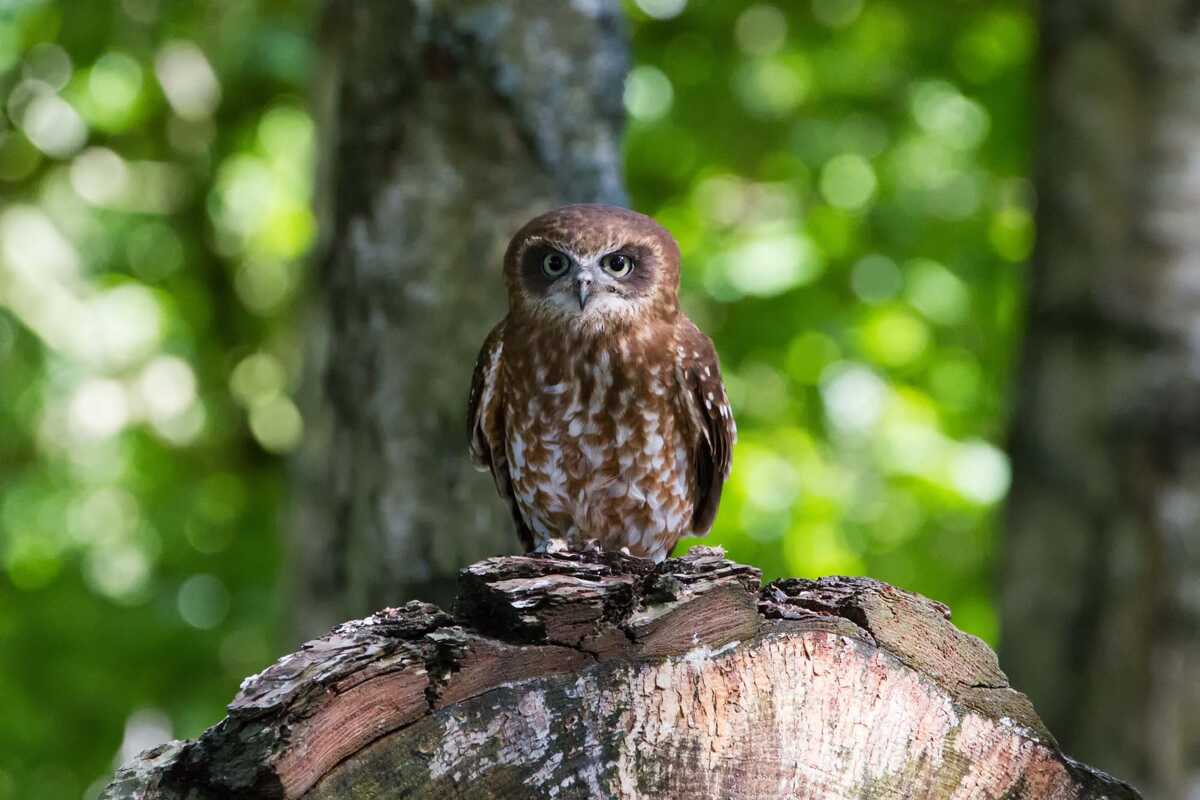
(Cacatua galerita) It's 44–55 cm long with white plumage and yellowish underwing and undertail. It has a yellow crest, a black bill, grey legs and whitish eye-rings. Males usually have almost black eyes, while females have red or brown eyes. Learn more at https://en.wikipedia.org/wiki/Sulphur-crested_cockatoo
Photo by Rob Russell (CC BY 2.0)
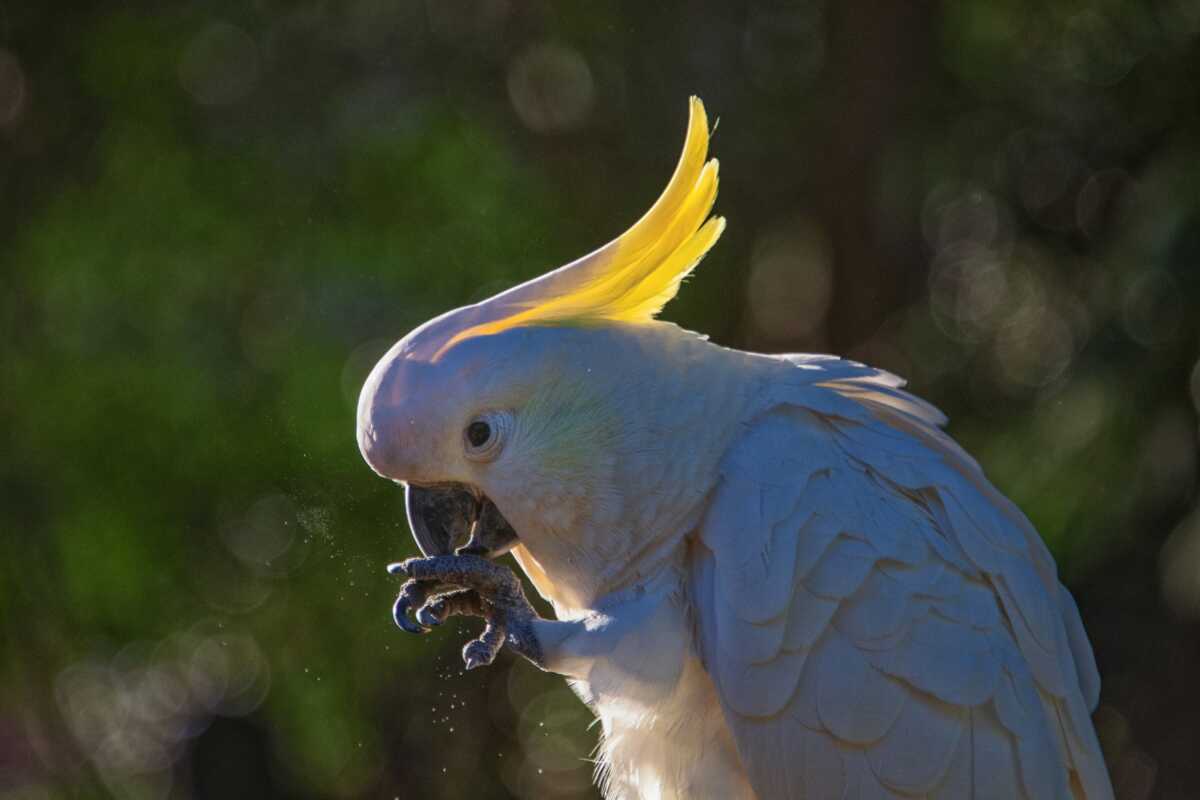
(Malurus cyaneus) It's 14 cm long. Breeding males (in winter or spring) have iridescent blue plumage with black and grey-brown, a brightly coloured crown and ear tufts, a bright-blue forehead, ear coverts, mantle and tail, brown wings, and black throat, eye band, breast and bill. Females and non-breeding males have plain fawn colour plumage with a lighter underbelly, a fawn tail and a brown bill. Their call is a 1–4 second high-pitched reel.
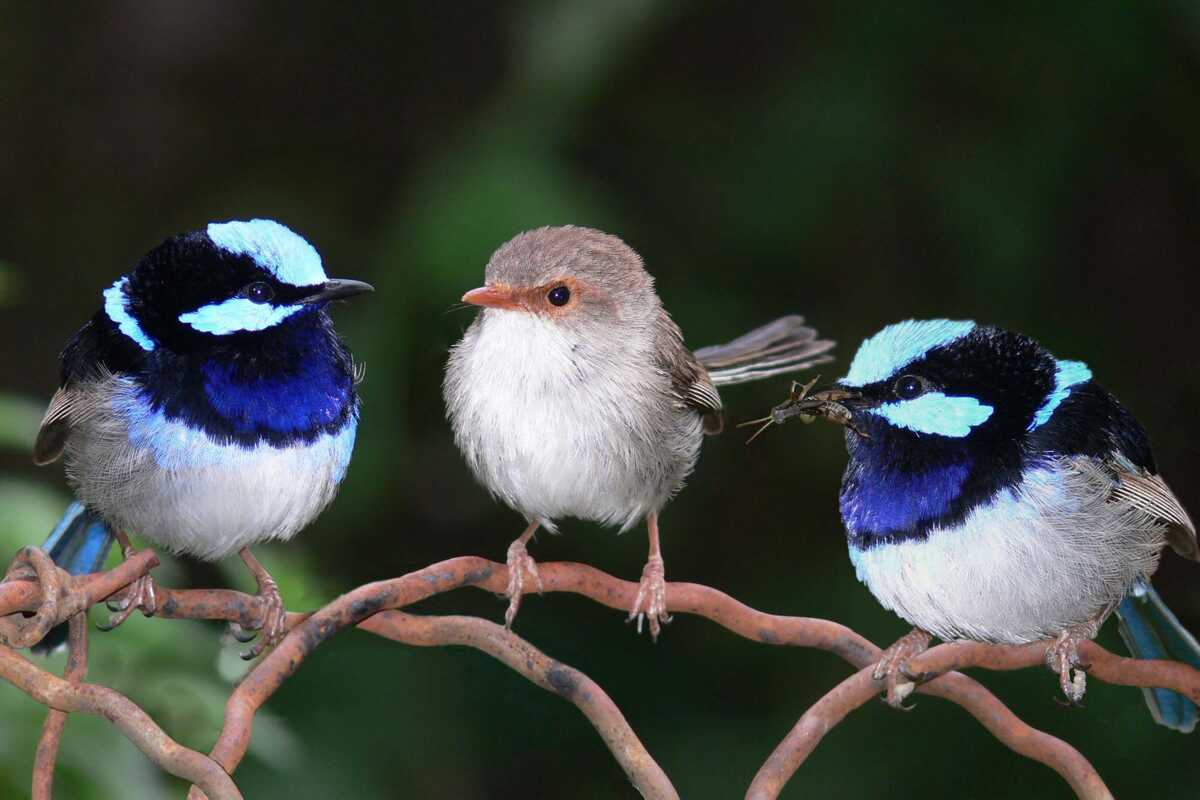
(Menura novaehollandiae) This bird is endemic to Australia. It's known for its elaborate 16 feathered tail (up to 70 cm long) and an excellent mimicry. It's 80-100 cm long with dark brown plumage on the upper body, greyish-brown underparts, red-tinged flight feathers and powerful legs that help it run very quickly.
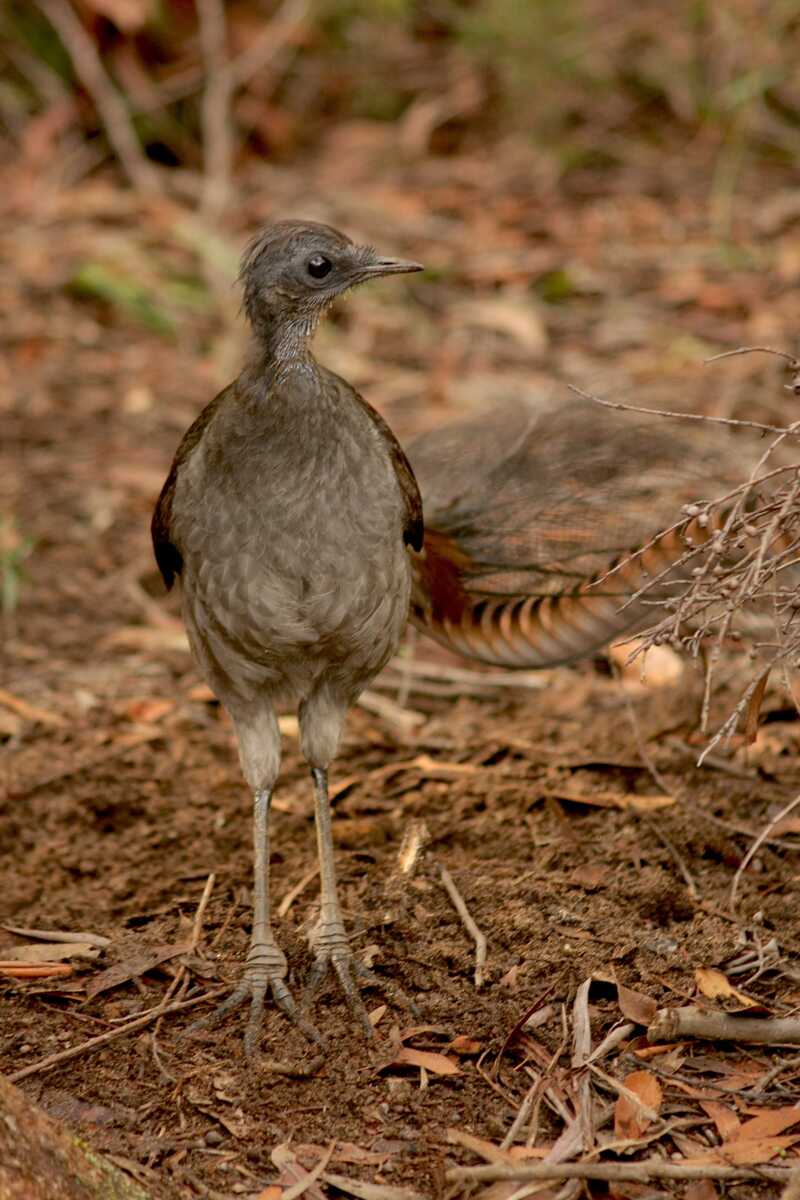
(Podargus strigoides) It's 34 - 53 cm long with grey plumage and a wide, heavy, olive-grey to blackish bill that is hooked at the tip and topped with distinctive tufts of bristles. Its eyes are large and yellow, which is why it's often mistaken for an owl. This bird is excellent in cryptic plumage and mimicry as they become practically invisible in broad daylight. Learn more at https://en.wikipedia.org/wiki/Tawny_frogmouth
Photo by Andrew Mercer (CC BY-SA 3.0)

The wedge-tailed eagle (Aquila audax) can be identified by its wedge-shaped tail and is the largest living bird of prey in Australia. It is also one of the largest eagles in the whole world with a maximum wingspan of 2.84 metres. Can be spotted at high altitudes as well as in woodlands and rural areas. Learn more at https://en.wikipedia.org/wiki/Wedge-tailed_eagle
Photo by Donald Hobern (CC BY 2.0)

(Rhipidura leucophrys) This bird is native to Australia. It's 19 - 22 cm long. Its short black bill is tipped with a small hook. It has black legs and plumage, with a white eyebrow, "whiskers" and underparts.It has a number of distinct vocalisations with a rapid chit-chit-chit-chit as a most recognised one.
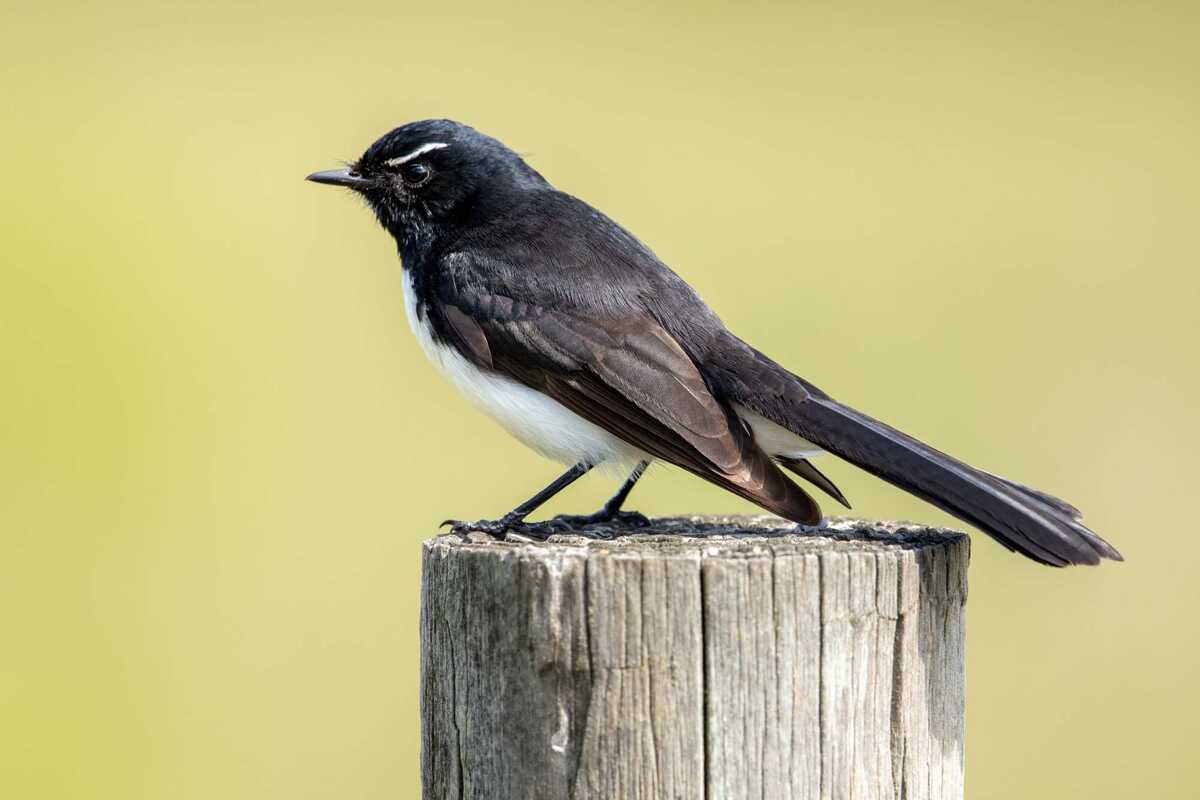
(Leucosarcia melanoleuca) It's 38 - 40 long with blue-grey back feathers, a white underside dotted with dark grey spots creating a distinct V pattern. Its head feathers fade to a creamy-white colour. Its eyes are a dark red-brown colour with pink eye-rings. It has red legs and a long tail.
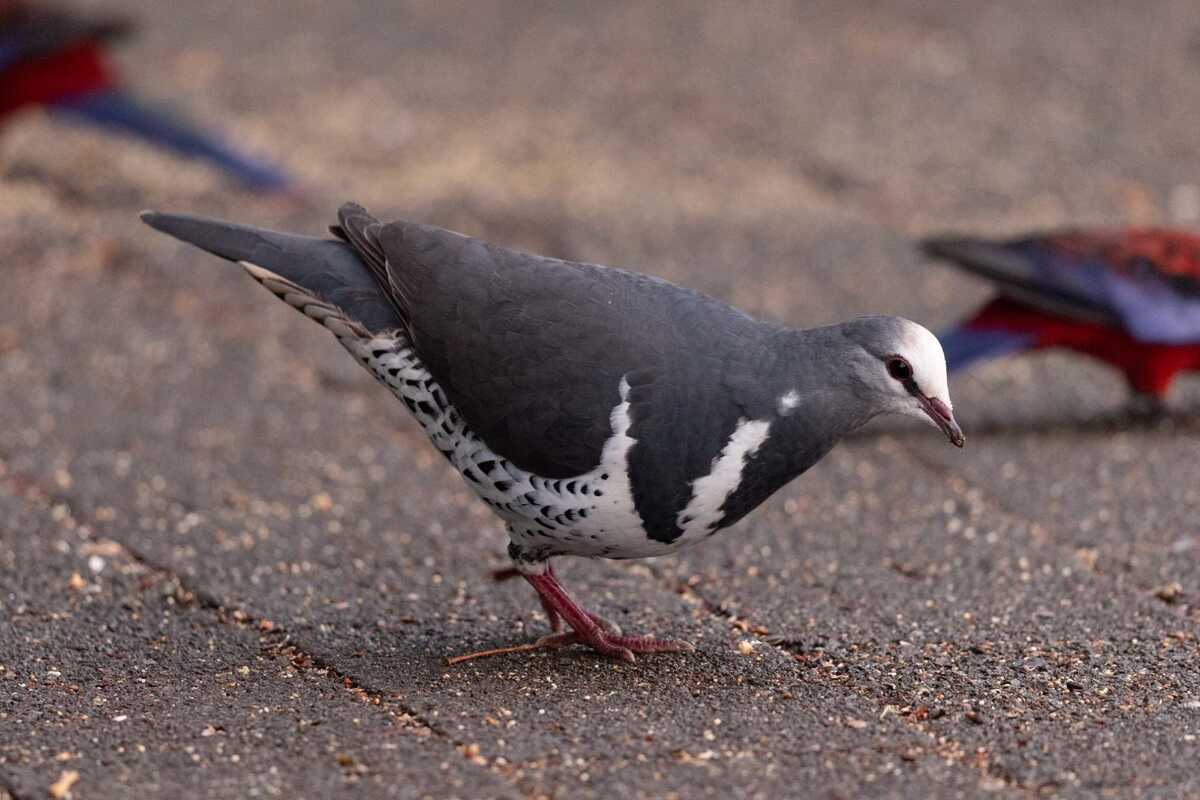
(Caligavis chrysops) It's 15–17.5 cm long with greyish-brown to olive-brown plumage with distinctive yellow stripes on the sides of the head that end in a small white patch of feathers on the ear coverts. Its eyes and bill are black. Its early morning calls are full and loud, and extremely varied.
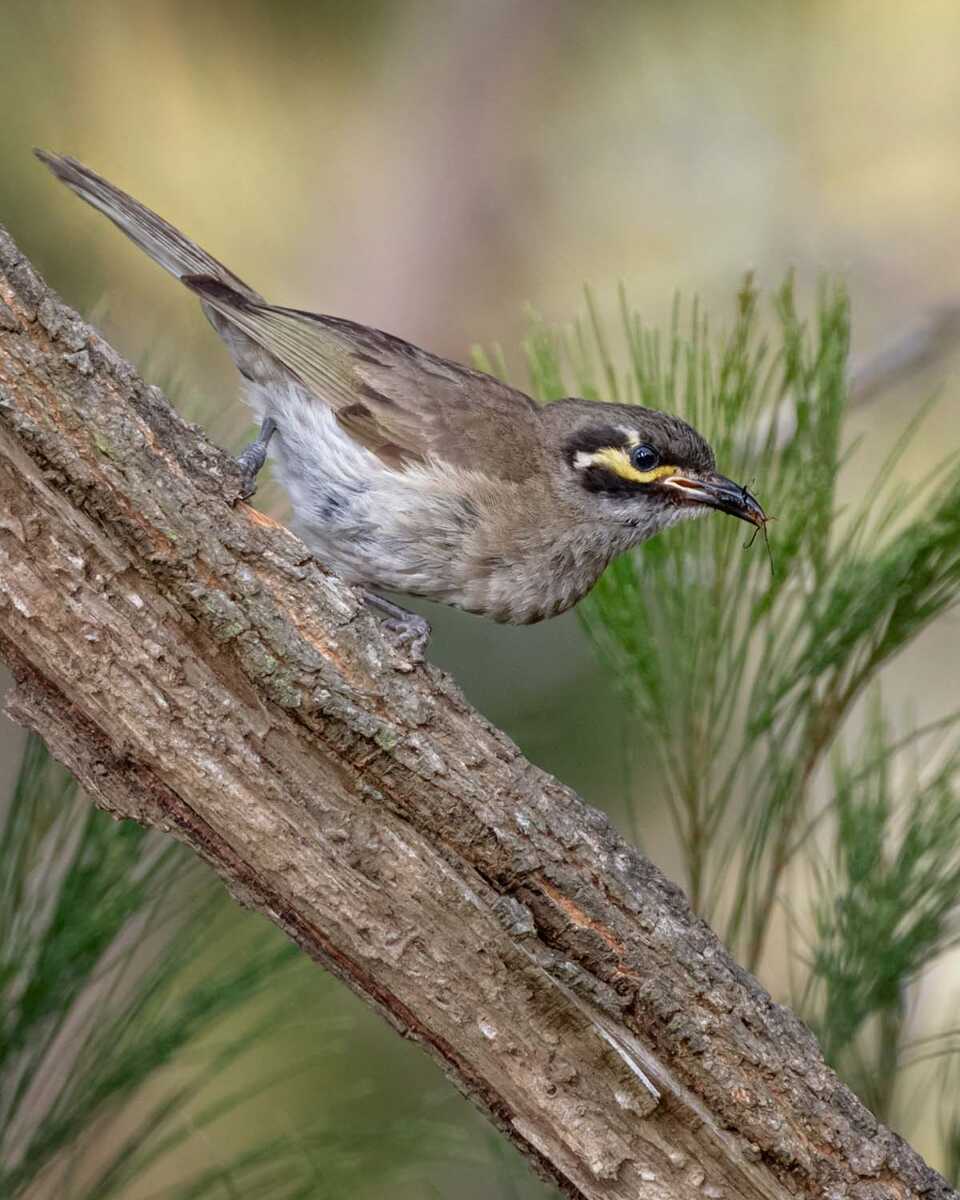
(Calyptorhynchus funereus) It's 55–65 cm long with a short mobile black crest, brownish-black plumage with paler feather-margins in the neck, nape, and wings, and pale yellow bands in the tail feathers. Males have a black bill, a dull yellow patch behind each eye, and pinkish or reddish eye-rings while females have grey eye-rings, a horn-coloured bill, and brighter and more clearly defined yellow cheek-patches.
